When building a country house it is important to pay special attention to the roof. It performs the most important functions that turn off protection against noise and precipitation. It is important that the roof is installed correctly, and the installation is made of reliable quality materials. Then the structure will be strong and durable. The roof should not be blown and leaky. In addition, it should look aesthetically and harmoniously together with the structure. Let's find out the best way to cover the roof of a wooden house, and consider each species separately.
Slate and ruberoid
These are the most affordable and economical options that are suitable if you want to cover the roof cheaply and quickly. Slate is a durable material that serves 30-40 years. It is resistant to negative moisture and precipitation, mechanical damage, withstands snow loads. However, over time, the edges of the roof begin to crumble, a fungus may appear on the surface, and the roof itself loses its original attractive appearance.
However, slate is not recommended to use to cover the roof of a wooden house, since it has a heavy weight and gives a heavy load on the structure and foundation. In addition, asbestos in the structure is harmful to human health, which violates the ecological and naturalness of the wooden house.
The ruberoid is an even more unreliable option, as it wears out in a short time. It is not resistant to the negative influence of wind, mechanical influences, temperature changes. The most reliable and durable euroreurite with bitumen impregnation will last up to 25 years, and the cheapest and simplest - no more than five years. To increase the service life of products, increase the sound and heat insulation, the sheets are laid in three to four layers. Of the pluses, we note an easy and quick installation, low weight and low cost.
Ruberoid should be used with caution for wooden buildings, as it is highly flammable. But slate and roofing material are perfectly suited as waterproofing materials, which insulate the attic and the roof, foundation of the house . These are available materials that are easy to stack. They effectively protect against moisture, groundwater and precipitation.
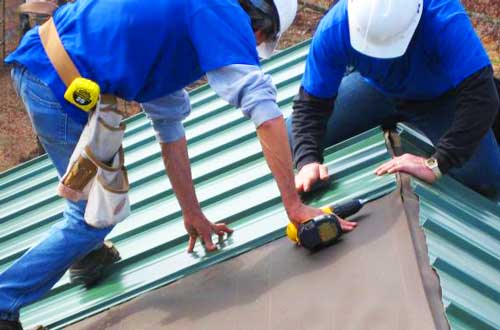
Profiled sheeting
Economical and affordable type of roof, which is used for both construction and repair. Profiled sheeting can not only cover a new one, but also cover the old roof in a private house, bathhouse or outbuildings. This roof is distinguished by its versatility, strength and reliability, a wide range of colors and a long service life. Environmentally friendly and light weight allow the use of corrugated board for small structures and wooden houses.
Profiled sheeting is made of galvanized steel in the form of wide sheets with outlines in the form of waves or a trapezoid. A protective and decorative layer is applied to the material from above. Easy installation allows you to install the roof of the corrugated board with your own hands in a short time and at any temperature.
Among the minuses, we note that during installation or transportation it is easy to damage the protective layer of the material. This will cause deformation and corrosion of the steel. In addition, the corrugated board makes a lot of noise during the rain. In the manufacture of complex roofs, including mansard, a large amount of material is required. Profiled sheeting requires additional heat insulation and waterproofing, and holes and cut places - in the required coloration.
Metal tile
This is the most popular and popular material for today, which characterizes high resistance to wear and durability, long service life up to 100 years! Metal tiles are made of profiled galvanized steel, which is covered with polymer paint. It easily tolerates the effects of moisture and various external factors, resists mechanical damage.

Such a roof reliably protects from exposure to sunlight, permanently retains color and an initial presentable appearance. It is an aesthetically attractive and environmentally friendly material. However, it is difficult to cut metal. In addition, such a roof must necessarily be insulated and make an additional layer of sound insulation. This complicates installation and increases financial costs, and after installation there is a lot of waste.
Metal tile has a small weight, so does not give a strong load or pressure on the structure and foundation. Due to this, the material can be used to create roofs with unusual configurations and shapes, for coating house with attic . Also, metal roofing is suitable for covering light buildings and wooden houses, as it is eco-friendly and light.
Ceramic and flexible tiles
Ceramic tiles are a reliable and durable coating that will last over 100 years. The material is resistant to moisture, wind, precipitation and other external factors. He does not miss the ultraviolet, and modern manufacturing and installation techniques increase physical properties and improve the appearance of the material. However, such material is expensive and has a heavy weight, so it is better not to use ceramic roofing for wooden houses and light buildings.
Flexible or soft tiles are made of fiberglass, which is impregnated with bitumen. On the surface of the roof are granules of stone, performing decorative and protective function. Seamless material is distinguished by a wide choice of shapes and colors, resistance to moisture and temperature changes.

Due to the softness of the flexible roof does not need additional waterproofing. It is suitable for the implementation of original design solutions, characterized by light weight and simple installation, elasticity and high thermal insulation. But keep in mind that this tile is more expensive than other types. In addition, it serves a relatively short time, about 20-30 years.
Ondulin
Ondulin - wavy light and strong sheets, which are produced from organic fibers and pressed cardboard with bitumen impregnation. An economical option simulates slate, while it is an eco-friendly and non-flammable material that is safe for humans and suitable for covering wooden structures. In addition, the ondulin has a light weight and does not give a strong load.
Ondulin sheets characterize high resistance to moisture and biological factors. On the surface of the roof does not form a fungus or mold, bacteria will not appear. In addition, ondulin is not released during the operation of harmful substances. Under the sheets, condensation does not accumulate.
The material is easy to cut and stack, so the installation of the roof can be done by one's own hands in a short time. Ondulin does not crumble and does not break down, does not leave much waste after installation. The flexibility of the material allows you to design curvilinear roofs, structures with arches and domes.
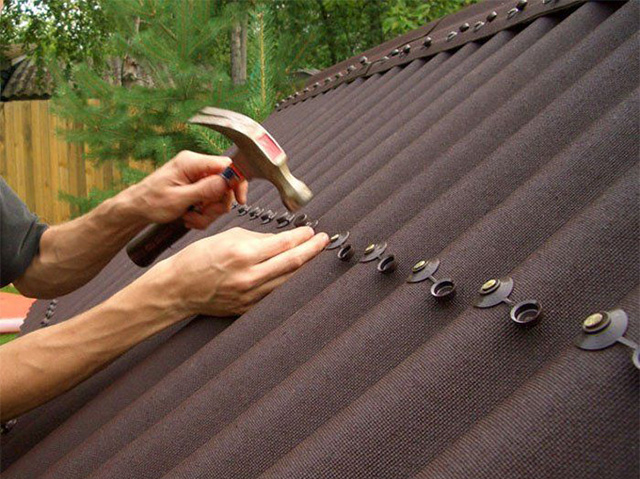
In addition, you will easily select the right color and shade of the product. Roof from ondulin does not require additional sound and waterproofing. It is distinguished by its reliability, strength and moisture resistance, it is not susceptible to corrosion and fireproof. Ondulin's roof will last for 50 years.
Natural roofing
Natural materials are most optimal for a wooden house. First of all, these include a wooden roof or shingles. It is important to choose the right grade of wood and use semi-transparent protective oils for processing. Then the wooden roof will last more than 30 years. Such a design is distinguished by aesthetic appearance, refinement and harmony, 100% environmental friendliness and safety, easy installation and low weight.
Wooden roofing is best done from larch or cedar. Wood "breathes", and when interacting with moisture (sediments) swells and closes, which guarantees reliable sealing. When drying, the shingles slightly bend, which ensures operative drying and airing. However, such a roof is highly flammable, so additional surface treatment with protective agents is required.
The reed roof is another kind of natural coating that characterizes ecological cleanliness and safety. This is a relatively new material, which is used as a specially grown water reed. It is highly resistant to moisture and strength. The reed structure does not swell and retains its original form. However, it is not yet widespread enough and is expensive.
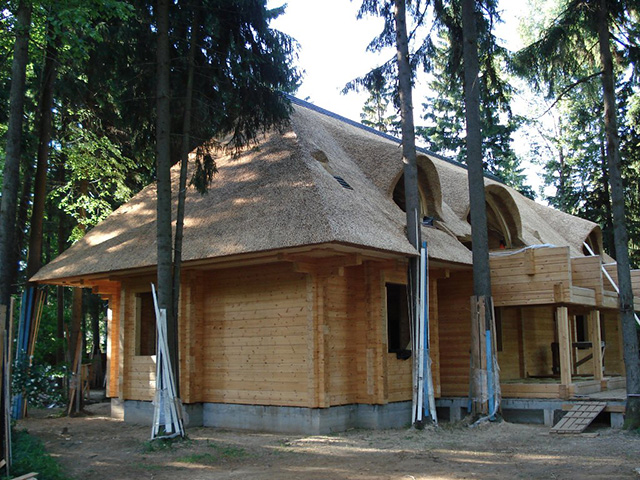
The best coating for a wooden house
If you do not know what to cover the roof for a wooden house, the appropriate options will be a natural wooden roof, ondulin and classic metal. You can use flexible tiles and corrugated board, for household buildings - slate. It is important not only to choose a reliable coating, but also to properly install the roof and truss system.
Without proper experience and knowledge in the installation of the roof, the coating will decrease, it will leak, deform and lead to other problems. To get a high-quality result, contact the professionals. Masters of the company "MariSrub" reliably and quickly carry out roofing work. We will choose a suitable coating, accessories and additional parts. We will carry out installation, warming and waterproofing, having sewed roofs.
We will install the roof roof and complex designs of roof windows! We offer a full range of services, which, in addition to installing the roof, includes the creation of a project and the production of sawn timber for the project, installation of a foundation and a log house, finishing, conducting and connecting engineering networks. We guarantee quality of work and strict observance of terms!
When building a house, we are faced with the question of what kind of coating to choose for a wooden house. Currently, the market offers a huge selection of building materials. Even without being a specialist in this matter, it is difficult to make the right choice if you take into account all the conditions of use and technical indicators of materials.
For good protection of the house from wind and rain, hot sun and various influences, you need to be able to choose the right roofing materials and take into account your financial capabilities.
Technological progress and industrial growth offer a huge number of new solutions for roofing. Ondulin, slate, metal, aluminum and galvanized sheets, roll and type-fitting roof are ideal for every owner and will allow you to make a choice that will take into account all aesthetic preferences.
Basic selection criteria for roofing
The roof is affected by atmospheric precipitation and sunlight, and choosing materials for the roof of the house, you must definitely take into account a number of certain categories. Such as:

If you have decided on the material that will be reliable, you will need to take into account that its longevity will be determined not only by its technical characteristics, but also by the features of its use, including the roof slope, high solar activity, and atmospheric precipitation.
Slate
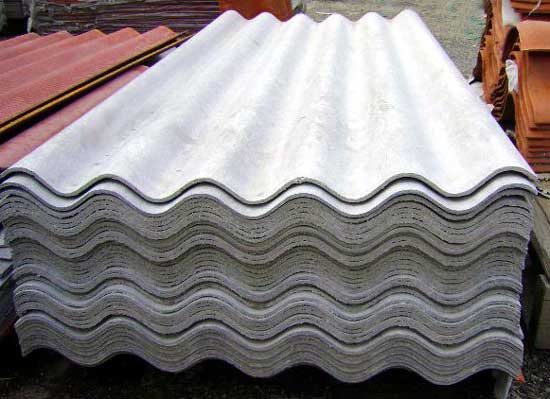 - this is wavy sheets made on asbestos-cement and Portland cement mortar. Due to such a mixture of solutions, the slate has become brittle, but at the same time it is longevity. All slate sheets have a standard length of 1750 mm, and the width lies in the range from 980 to 1130 mm. This material is used to cover the roof of the house, the use of which occurs in conditions of sharp temperature changes, Slate is one of the few building materials that is highly resistant to this criterion.
- this is wavy sheets made on asbestos-cement and Portland cement mortar. Due to such a mixture of solutions, the slate has become brittle, but at the same time it is longevity. All slate sheets have a standard length of 1750 mm, and the width lies in the range from 980 to 1130 mm. This material is used to cover the roof of the house, the use of which occurs in conditions of sharp temperature changes, Slate is one of the few building materials that is highly resistant to this criterion.
Another plus of such roofing is ease of maintenance and long term use. Although, with its ease of installation and installation, slate requires accuracy due to its fragility.
This roofing building material lost its position in the overall popularity rating, because under the influence of atmospheric precipitation it very quickly loses its attractive external data, acquiring a dirty, dark shade. To eliminate this problem, special paints have been removed, which help the slate to remain attractive for a long period of use.
 Houses, outbuildings, sheds and garages are not yet a complete list of building structures for which slate is the ideal solution due to its durability and low cost.
Houses, outbuildings, sheds and garages are not yet a complete list of building structures for which slate is the ideal solution due to its durability and low cost.
When purchasing slate in the store, pay attention to the integrity of the sheets, and discard those that have through and through cracks, holes, shells, dents and various inclusions. The edge of the slate sheets must necessarily have a flat edge.
Aluminum and galvanized sheets
The main advantage of this solution is reliability and durability, besides these sheets are not a fragile building material. It is worth paying special attention to the crate of the metal roof, it must have the most frequent step or be continuous.
Installation and installation is carried out with the help of special folds, which there are 4 different types:
- single standing seam;
- single recumbent fold;
- standing double fold;
- double recumbent fold.
 Depending on the metal used, the roof covering of the house is divided into three categories. The first category includes the use of galvanized material and it has a maximum period of operation. With such a roof, you do not have to worry about building and repairing for many years. Covering houses made of non-zinc or decapitated material will be less durable.
Depending on the metal used, the roof covering of the house is divided into three categories. The first category includes the use of galvanized material and it has a maximum period of operation. With such a roof, you do not have to worry about building and repairing for many years. Covering houses made of non-zinc or decapitated material will be less durable.
The sheets have a low weight, so they are widely used to cover roofs with a slight slope.
Aluminum sheets have a longer service life, but their cost is much higher than conventional metal sheets. Aluminum is resistant to various corrosive processes and the roof with this coating will serve more than 80 years.
These sheets also have a number of drawbacks, including noise during heavy rain, and lack of protection against temperature changes. Buying such a building material, pay attention to the accuracy of the shape of all sheets, their smoothness of the surface and the presence of a characteristic pattern of crystallization of the zinc material.
Metal tile
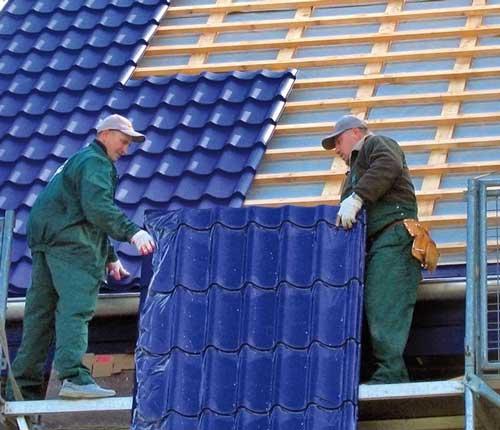 Is a profiled sheet of galvanized steel, and which, because of its profile, is very similar to tiles. The surface of this material undergoes a special procedure for coating with paints and high quality anticorrosive compounds. The large use of metal can be explained by its long operating life, ease of installation and installation, durability and beautiful appearance. But this building material also has a number of shortcomings.
Is a profiled sheet of galvanized steel, and which, because of its profile, is very similar to tiles. The surface of this material undergoes a special procedure for coating with paints and high quality anticorrosive compounds. The large use of metal can be explained by its long operating life, ease of installation and installation, durability and beautiful appearance. But this building material also has a number of shortcomings.
When choosing a metal to cover a country house, quality and appearance of protective special polymer coatings play a significant role. Among the most popular are polyester, polyurethane, plastisol and matt polyester. These coatings are used with steel. But much more often used polymer coating purala 50 microns and steel 0.5 mm. Under such conditions, a high-quality roofing with high technical parameters at an affordable price is obtained.
Another important point that requires special attention is the color of the metal tile. Here it is necessary to focus on personal preferences, but one should take into account the fact that with the fading of shades of darker shades this will be more noticeable than with light shades.
Ondulin
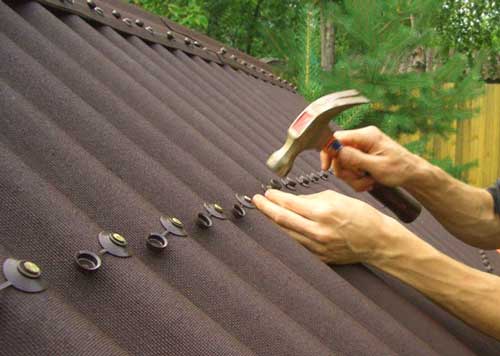 - this is corrugated pressed cardboard, impregnated with bituminous mastic. The surface of this material is stained several times, for a higher durability. The term of use of this roofing material is 35 years.
- this is corrugated pressed cardboard, impregnated with bituminous mastic. The surface of this material is stained several times, for a higher durability. The term of use of this roofing material is 35 years.
Another advantage of ondulin is its low cost, low specific gravity, ease of installation, its hydrophobicity, high resistance to the action of various bacteria, fungi, low cost, both the material itself and installation work.
Although, this roofing of the country house is not without its drawbacks, the main one of which is low mechanical strength, and a loud noise of rain drops and hailstones falling on the roof.
During use, this material burns out and loses its original appearance.
A reliable ondulin of high quality can burn out evenly when burned, so when choosing this coating, be sure to check the surface of the sheets for uniformity of painting. It is also worth noting that ondulin will require constant care in the form of cleansing from various debris and dust. This feature has appeared because of the special velvety surface of the ondulum matte color.
Mastic roof
Mastic roof - polymer film, which is applied to the roof surface. The mastic applied on the roof has the same set of physical qualities as the rubber coatings. This design has gained its popularity primarily due to monolithicity, good, increased heat resistance and ultraviolet radiation.
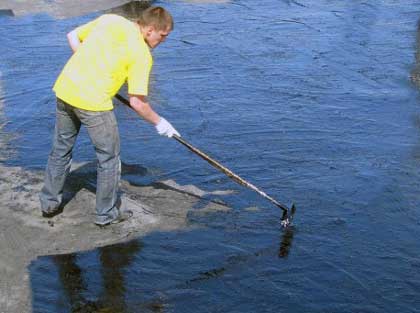 Many professionals prefer this type of roof because of the fact that the installation does not form joints. As part of the mastic, there is asbestos fiber and cement, and this makes it resistant to external atmospheric precipitation and sunlight. Installation and installation of this roof is less labor-intensive and takes much less time than roll materials. Mastic can be poured on monolithic heaters, various reinforced concrete slabs without any additional special procedures.
Many professionals prefer this type of roof because of the fact that the installation does not form joints. As part of the mastic, there is asbestos fiber and cement, and this makes it resistant to external atmospheric precipitation and sunlight. Installation and installation of this roof is less labor-intensive and takes much less time than roll materials. Mastic can be poured on monolithic heaters, various reinforced concrete slabs without any additional special procedures.
Mastic is used as a repair construction material, to eliminate small cracks and minor damages on the roof.
Roll roofing
A roll roof is a fabric or cardboard base with bitumen applied to it. 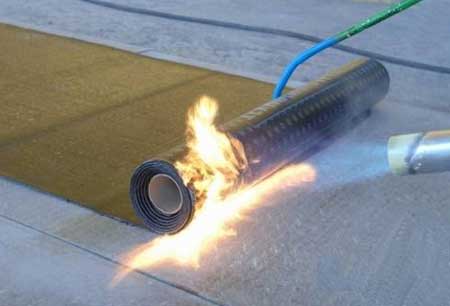 Under this roofing concept, a well-known ruberoid hides, and from newer technological materials it is parchment or glass. The last two materials have increased heat resistance and frost resistance. When choosing a roofing material for the outer covering of a house with a durable coating, stop focusing on roll coatings on synthetic fabrics.
Under this roofing concept, a well-known ruberoid hides, and from newer technological materials it is parchment or glass. The last two materials have increased heat resistance and frost resistance. When choosing a roofing material for the outer covering of a house with a durable coating, stop focusing on roll coatings on synthetic fabrics.
For laying this material a special flooring is applied in several layers, impregnated with liquid bitumen. Additionally, the sizing is performed to close all joints. In order to increase the mechanical resistance over the roll roofing material, various mixtures are covered. For example, small gravel or coarse fractional sand.
Various types of roofing
In this category of roofing falls shale and ceramic tiles. Lay it with individual elements on a frequent crate. Professionals believe that ceramic coatings are more profitable and technically advanced materials. Through the introduction of industry innovations, ceramics has acquired a beautiful appearance and durability. When installing the shingles, remember that it has a fairly high specific gravity and assumes the presence of a rafter stable frame.
Even in the process of designing a private house, you need to take care of the correct choice of roof for it. Roof cover protects buildings from all kinds of atmospheric influences, provides comfort of living in it, extends the life of walls, regardless of what materials they are built.
Today, the market presents an incredible variety of materials for the roof, so their choice is quite a challenge. For its effective solution, it is best to focus on all the factors listed here:
- features of the roof construction of a particular building;
- climatic conditions in your region;
- own requirements to the appearance of the roof, its reliability, resistance to certain influences;
- cost of materials.
There are only two main types of roofs - pitched and flat. The latter are often covered with roll materials - roofing felt and products based on it, however such roofs in private houses are very rare. Therefore, we will not pay much attention to them, we will concentrate only on those coatings that are used for pitched structures. They are divided into two large groups, in each of which you can find both expensive and relatively cheap materials.
Sheet roof: convenience and practicality in installation
 Leaf coverings are ideal for any private house, easy to install, in most cases are equipped with a wide variety of additional elements, which allow creating aesthetic and reliable roofs. This category includes the following materials:
Leaf coverings are ideal for any private house, easy to install, in most cases are equipped with a wide variety of additional elements, which allow creating aesthetic and reliable roofs. This category includes the following materials:
- metal tile. The most popular and relatively inexpensive roof, made of galvanized steel sheet. The latter in the manufacturing process is covered either with powder paints or with a polymeric protective layer, which prevents corrosion of the metal. Advantages - effective appearance and durability, wide choice of color solutions. The disadvantages of roofing with metal roofing are the need for additional sound insulation and a lot of problems when using the material on complex roofs;
- profiled sheet. Performed in exactly the same way as the previous coating, but differs from it with increased strength. And, accordingly, a higher price;
- sheet materials based on bitumen. They have excellent soundproof characteristics, are not exposed to moisture. If you intend to cover the roof with onduline, you can also do a long time without repairing it and complicated maintenance;
- if you want to save money, it's best to cover the roof with slate - wavy sheets made from asbestos cement. This material serves several decades, has a high resistance to temperature changes. The disadvantage is the high fragility of the sheets;
- sheet copper. Ideal choice for roofing. Soft non-ferrous metal allows you to build a beautiful and solid roof, which will last a hundred and fifty years. The most important disadvantage is the very high cost of copper, because of which it is used exclusively in elite cottages.
Piece materials for creating a beautiful and durable roof
 Not less often as a roofing covering for private buildings are used and such materials as:
Not less often as a roofing covering for private buildings are used and such materials as:
- tiles, made from baked clay in special furnaces. This coating has been used for many centuries and managed during this time to repeatedly prove its reliability and durability. It is resistant to direct sunlight and temperature changes, very low thermal conductivity, so that the house remains pleasantly cool even in hot summer. By cons are only heavy weight and, accordingly, increased load on the base of the building;
- composite tiles, which in its performance characteristics are not inferior to ceramic. However, unlike it, it is much easier, which allows you to reduce the load on the foundation to a minimum;
- bituminous shingles. Its main advantages are excellent sound, heat and waterproofing, resistance to any aggressive environmental influences. There are no shortcomings to date, which is why the coverage enjoys a very high demand among domestic consumers;
- shale coating, made of natural stone. It is quite expensive, but the minimum period of its operation is 200 years.
It is simply impossible to mention such relatively inexpensive but very reliable coatings as cane or water cane. The stems of these plants in dried form make it possible to create environmentally friendly roofs that do not require the construction of a so-called roofing cake, the performance of heat-insulating and vapor-proof works. Today the reed roofs are quite deservedly ranked among the elite. And not at all because of the high price, but because of the spectacular appearance and environmental safety.
The beauty of the roof of the house depends on many factors, but the main role is played by roofing. The correctness of the choice of coating for the roof depends on how thoroughly the material has been analyzed and all its properties have been correctly evaluated. Only after a detailed study of the roofing materials market can a decision be made, the better to cover the roof of the house, which flooring will cost less.
The main characteristics of roofing, which should be taken into account at the time of purchase of building material:
- The combination of the configuration, color and texture of the roof with the facade lining of the house, the style of the landscape;
- Strength, durability, stability of the roof to numerous external influences;
- The mass of roofing modules affecting the way the rafter system is erected;
- The complexity and cost of installation work for the installation of the roof;
- Plasticity, the possibility of forming a roof of complex shape;
- Degree of noiselessness of the coating under the influence of precipitation;
- Price category of construction materials.
Comparative table of properties and cost of roofing materials:
Roofing material | Advantages | disadvantages | Price, rubles / m 2 |
Acceptable cost. Variability of shapes and color palette. Ease of installation. Mechanical strength. Light weight. Moisture and frost resistance. | Risk of corrosion. | ||
Flexible shingles | Presentable appearance, variety of colors. Ease of installation and repair. High heat and sound insulation. Moisture resistance. | Deformation in the case of temperature changes. | |
Ceramic tiles | Noble appearance. Excellent sound and heat insulation. Durability is of the order of 100 years. | Significant weight. High price. Labor-intensive installation. | 1000 and more |
Affordable price. Lightness and strength. Ease of installation and repair. Ecological and biostability. Frost and moisture resistance. Attractive appearance, wide range of colors. | Short-lived (up to 25 years) High fire hazard. Exposure to deformation from mechanical influences and temperature changes. | ||
Budgetary cost. Frost and moisture resistance. Simplified installation scheme. | Low level of noise and heat insulation. Low strength, especially along the edge of the roof. Exposure to the formation of fungal and mold foci. | ||
Profiled sheeting | Low price. Durability provided competent installation. Simplified installation scheme, easy repair. Moisture, frost, fire resistance. Light weight. | Low noise and thermal insulation. Exposure to corrosion. Need for a lightning rod. |
Traditional roof tiles
Tile refers to the oldest roofing materials, known since ancient times. If before it was produced only from clay, now sand-cement and lime-sand mixtures are used, covering with colored glaze or engobe, achieving high wear resistance of the modules. The key advantages of classical tiles are its ideal durability (about 100 years) and environmental friendliness, fire, water and frost resistance, quietness and low costs when operating the roof.

The main drawbacks of the traditional tiled roof are fragility, high cost and massiveness, which requires significant strengthening of bearing walls and arrangement of a powerful foundation. Among other things, when the roof is made of tiles, a steep slope is needed to effectively drain the stormwater and drain it, and the installation of the floor is significantly complicated due to the material's stiffness.
Metal tiles are made from profiled metal sheet (steel, copper, aluminum) with protective zinc and decorative polymer coating. The beauty of the material is achieved through styling under natural ceramic tiles. High aesthetics and resistance to burn-out, reliability and durability, ease of installation and budget cost - these are the key advantages of a metal roof. In addition, a small mass of metal tiles can significantly simplify the truss system and the construction of the foundation, reducing the cost of building the house as a whole.
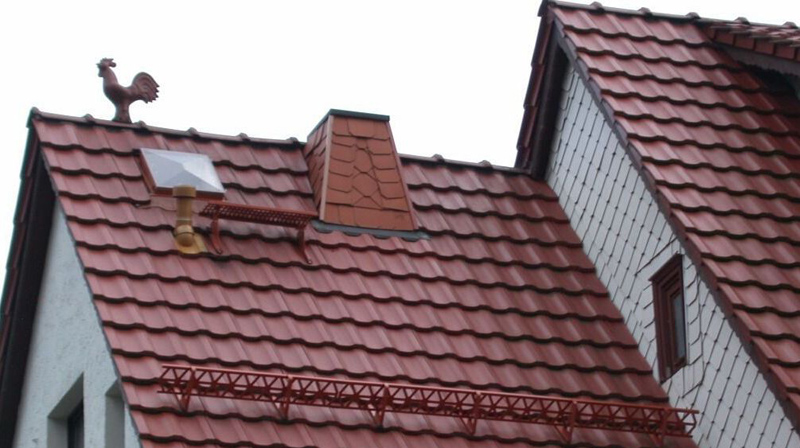
The disadvantages of metal flooring include:
- Corrosion susceptibility, especially in areas with a damaged polymeric layer, in the places where the sheets are cut and along the outline of the mounting holes.
- High noise, the need for a sound insulation of the roof.
- Increased thermal conductivity, requiring high-quality thermal insulation coating.
- Metal creates a bridge of cold, due to which in the under-roof space of a metal-roof roof, condensation forms - it is necessary to install a sealed membrane.
Flexible roofing (bitumen shingles) is made of glass fiber, impregnated with bitumen and enriched with colored stone powder. This roofing is moisture resistant and not subject to corrosive processes. The flexible tile is plastic, which allows it to be used to equip spherical and dome-shaped roofs, as well as roofs of complex geometry. A small weight, a variety of shapes and shades, noiselessness - the cardinal advantages of the material. The main disadvantage is the high cost of installation, which requires the arrangement of a solid base flooring made of wood or plywood. In general, flexible tile is cheaper than ceramic, but more expensive than metal.

The modern kind of flexible roof tiles is the roofing material of Onduville. This coating, which maintains the bulk and uniformity of color throughout the life of the product. Onduville perfectly waterproofs and does not make noise in the rain, does not heat up in the heat and does not crack in the cold. Under such a roof condensation does not accumulate, and the installation and transportation of the material is simplified due to the small format of the modules.
Ondulin is a practical and budgetary material for roofing, imitating slate. Lightweight in weight, quiet and moisture resistant, strong and flexible, easy to install - plus ondulin weight - due to this, he won the love of many private developers.
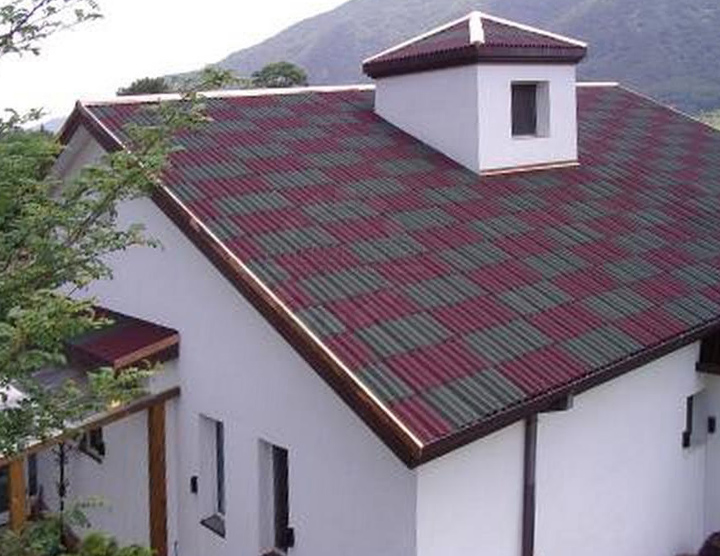
Advantages of ondulin:
- Reduced weight of the roof, due to the small weight of the sheet and narrow end overlaps.
- Easy installation without marking and leveling of sheets due to convex guides and finished holes for hardware.
- Excellent waterproofing properties due to the locking system when installing the lap.
- The fastening elements for the sheets are equipped with cast hats with a sealing ring completely overlapping the mounting holes.
Slate - the usual for a wide range of homeowners, relatively durable (about 50 years) and cheap roofing. It is sealed, mechanically stable and strong enough. Disadvantages - the tendency to destroy the edges, susceptibility to the spread of fungus and mold.

Roof flooring from profiled sheets refers to low-cost and quick-erectable. Insignificant weight, strength, wide color palette - such advantages of the material should be highlighted. However, the shortcomings of the profiled sheet as a roofing material also suffice: it requires careful sound-, heat-, waterproofing; is susceptible to corrosion; extremely noisy in the rain.
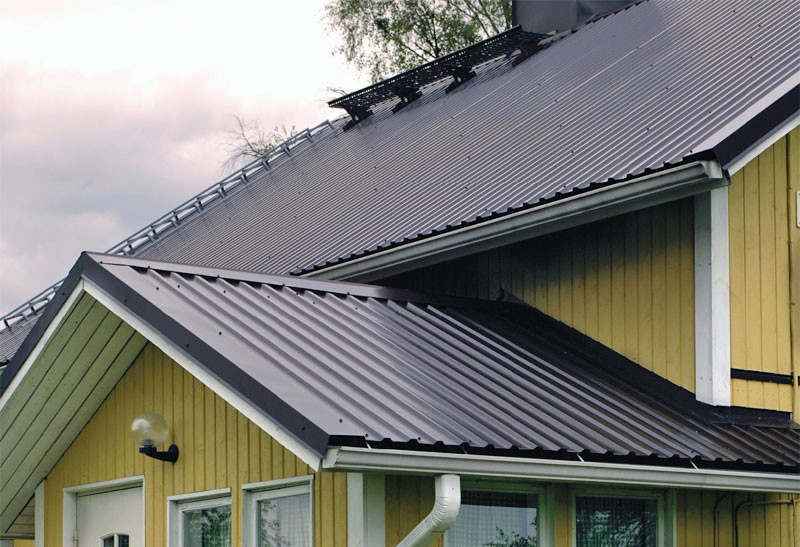
Conclusion
All modern roofing coatings are beautiful, but in terms of their performance parameters and the price category are strikingly different. If you are trying to equip the roof for many years, choose ceramic or metal shingles, but be prepared for the high cost of the material. The purchase of flexible shingles and ondulin (Euroshire) will be cheaper, and the purchase of slate or profiled sheet will be the most economical.
As you know, a competent choice of roofing material is the guarantee of a reliable and strong roof. Today this issue is very relevant, since a huge assortment of roofing covers assumes the presence of a mass of options that differ from each other in appearance, quality characteristics and price. When deciding how best to cover the roof of the house, it is necessary to take into account some parameters that allow to determine which roofing will be more suitable. Of the roofing flooring of this category, perhaps, perhaps, only ondulin, which is a wavy slate. He has a fairly wide range of positive qualities, moreover, staunchly tolerates high temperatures. In addition, the affordable cost of ondulin makes its use on the roof quite acceptable. Mount this cover is not at all difficult, which also applies to its positive aspects.
Another popular version of the roofing material is slate. By the ratio of quality and price, this coverage is quite good, because at its quite affordable cost, the technical characteristics of the material are quite good.
Technical characteristics of roofing
When building a private house, the use of ondulin is quite acceptable due to its low cost, good quality and very light weight. The basis for the creation of ondulin is a solution based on bitumen and fiberglass, so that the coating, although it turns out to be reliable, but it is not able to withstand the substantial temperature changes. For such a flooring, it will be necessary to mount a continuous crate system so that the onduline sheets do not deform and maintain their reliability.
Roof of roofing material - an excellent option for temporary roofing. Bitumen solution and cardboard are involved in its production, from which it becomes clear that the strength and fire resistance of the material to the fire are extremely low (read: "").

When answering the question about what is better to cover, we can say that the use of slate is a very good solution. He staunchly endures bad weather and loads of a mechanical type, and a small cost and made this material almost the most popular. Perhaps the main lack of slate is a non-aesthetic appearance, as this criterion is often the number one requirement today.
Another roof covering, which has a mass of varieties - tiles. In total, there are five of its main types, with each of them different in its own way.
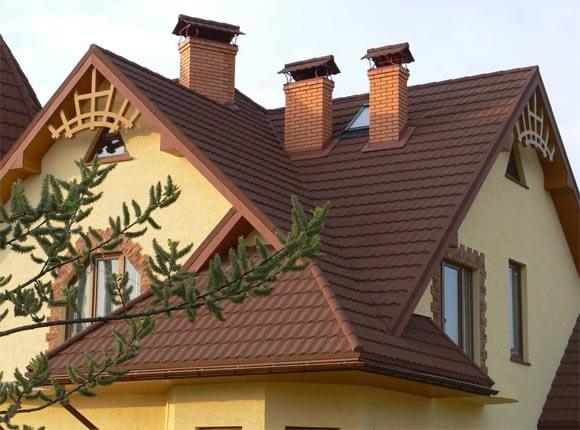
Roof tiles are of the following types:
- Natural shingles, the raw material for the production of which is a solid rock rock. Provided that all the requirements and conditions necessary for installation have been met, this shingles can last very long. The material has excellent resistance to any kind of impact, so that its durability is felt to the fullest. The most important disadvantages of this flooring are too much weight and high cost of both the material itself and its styling.
- Sand and cement shingles. If you decide on what material it is better to cover the roof hard, it is possible to use this coating, which is almost no different from natural shingles. But the kind of greater fragility of this material must be transported and laid carefully. One of the main advantages of the material is its affordable cost.
- The most common type of tile is metal. Its main advantages are low cost, light weight of material and easy installation, if you understand, since the dimensions of the sheet of metal are large. Before that, it's important to make the right calculations.
- Bituminous tile, which refers to the soft roof. With its help, you can equip even the most complex sections of the roof, without spending a lot of time and without the special material costs. The main disadvantages of bituminous shingles are the need for a continuous crate, as well as poor resistance to natural influences.
- Clay tiles, increasingly used in modern construction due to a number of reasons. Therefore, having no clear data on how best to cover the roof of the house, you should take advantage of the most convenient and at the same time high-quality option for hiding the house.
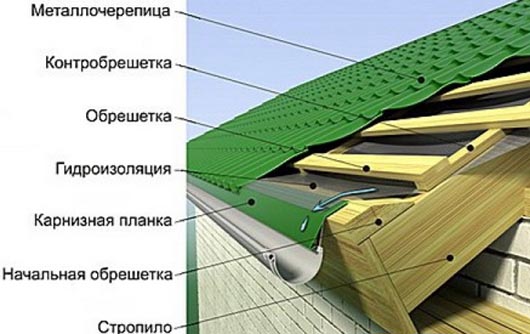
You can also pay attention to such a recently become popular material, such as Euroshow. Due to its ease, the installation of the Euro-scope does not carry any difficulties and is performed quickly, without requiring a large amount of labor. The insulation properties of the roofing of the structure also improve.
Resistance to damage of any nature makes the life of the slate even longer. In addition, the appearance of the coating also meets all modern standards and allows specialists to realize practically any design decision regarding the roofing system.
Selection of roofing materials
When choosing a roofing, one should not forget, first of all, the functions it is supposed to perform, as well as the comparison of standard criteria. These criteria include the combination of the coating with the walls of the house in color, the quality of the flooring used, as well as its price.
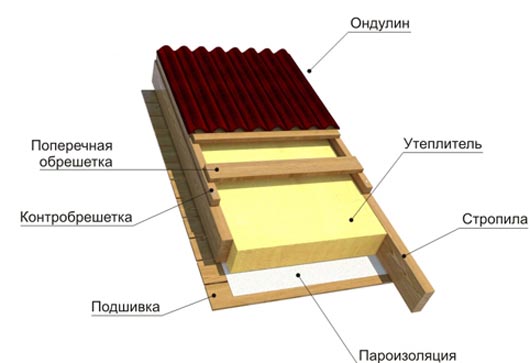
When choosing a roofing material, you should keep in mind the special stowage rules and do not forget the advice of professionals, which will allow you to make the right decision in favor of a particular coating. Provided that the entire structure is not large enough and is not equipped with a complicated roof configuration, the best option for the roof installation is the use of bituminous slate or galvanized steel.
Coverings for buildings of economic and technical type
The construction of any private house, of course, assumes the presence on its site of special buildings of technical and economic type, the roof of which should also be arranged according to all the rules. However, for these structures, the roofing can be chosen inexpensively, guided by the practicality and reliability at the same time. These materials include a standard slate, the technical characteristics of which are quite normal, and the price is absolutely acceptable.
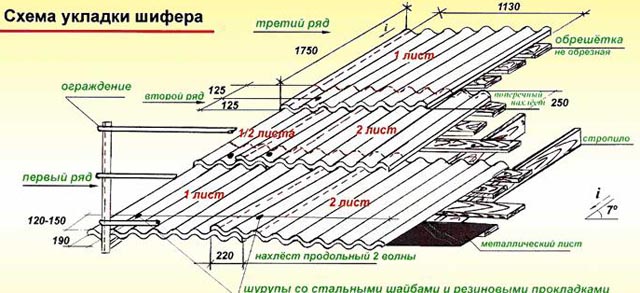
It happens that the appearance of the material does not harmonize well with the design of the site. To do this, it is recommended to paint the slate with a special paint, which can not only give aesthetic design, but also provide the roof with additional protection from external influences.
The profiled sheet is more durable and durable, but this is expressed in its price, and the cost of the entire installation, thereby, is increased. If desired, you can save money and use roll or bituminous materials, but this will increase the need for more frequent and thorough maintenance of the roof structure.

Drawing a conclusion from all of the above, it can be confidently asserted that the roof covering should be selected exclusively in accordance with the individual characteristics of each particular roof structure. The necessary knowledge of the characteristics of all materials will help to make the best choice, the most suitable for each owner in the ratio of price and quality. If you want any information on the types of roofing with photo samples and detailed video of their stacking can easily be found on the Internet at specialized construction sites and forums. The optimal solution for the device of a specific roof.
What should I look for when selecting materials?
Determining with what material it is better to cover the roof, it is recommended to be guided by the following criteria:
- variety of material forms;
- color ratio;
- weight of the whole roof (for the construction of a bearing roof frame);
- the price of the coating and works for its laying;
- indicators of reliability and quality of the coating.
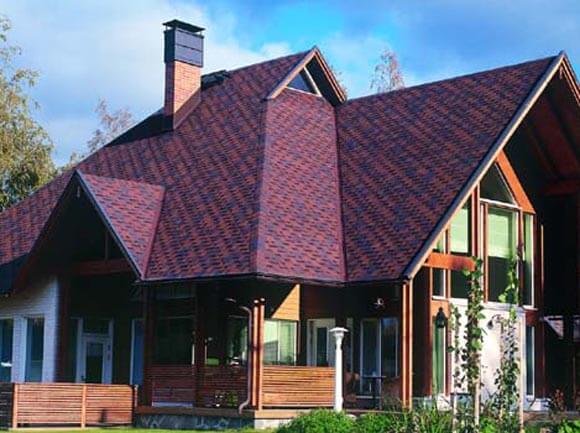
The weight that has a roofing is a very important parameter that must be taken into account when building a house, since a properly distributed load on the roof support system and the roof itself will significantly increase the reliability and operational life of the entire structure as a whole. For this reason, any calculations designed to calculate the bearing capacity of the roof must be carried out even before the acquisition of a particular material for the roof.
Therefore, choosing the better to cover the roof of the house, it is necessary to take into account each of the characteristics of the roofing material used during the installation.
A common roof today is the soft roof, the basis for the manufacture of which serve as bituminous materials or roofing material. Such roofing for roofing will be optimal as a temporary covering or covering for rooms of technical or economic type, where the roofing systems are shallow (more: ""). The main disadvantages of this material are poor resistance to natural and mechanical influences and a short operational period.
